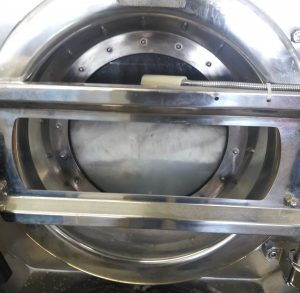I have been covering the general principles of wetcleaning for the last several months. Starting this month, I will be explaining more technical side of it. These topics need to be understood before you try wetcleaning. Even though you are already doing it, I hope you read it just to make sure.
The first thing to understand for successful wet cleaning is water quantity and chemicals. This point can never be over emphasized. As long as you keep these two points, you are 90% there.
Presently, there is no one right method for wet cleaning. Different companies offer different solutions. Due to this confusion, many new wet cleaners experience failure due to shrinkage, color loss, color transfer, loss of finish and rough touch. But most of these problems can be solved by two points mentioned above.
Water quantity

I started developing wet cleaning programs more than 10 years ago. Needless to say, I went through many accidents. Sometimes I created accidents for experimental purposes.
Wool sweaters and suits shrinking, dark silk blouse loosing color, white skirts with transferred dyes… you name it, I had it. I had to throw away so many good clothes in the garbage. Even clothes my wife loved more than me.
At that time, I was trying to conserve water. But as problems continue, I realized using less water in wet cleaning was a losing proposition. Damn the water conservation and I filled the drum with high level of water and started a gentle cycle. The result? I couldn’t believe what I saw. Most of my problems just vanished. Just by using more water.
Benefits of more water
You have a lot to gain by using more water. When you have a lot of water in the drum, friction among clothes goes way down. This alone prevents felting and shrinkage. It also reduces friction-induced color loss.
More water also dilutes color problems. Even if color loss occurs, dilution by more water protects other clothes. Since clothes do not rub against each other, color transfer problem is reduced. So is the mechanical action.
The best part about wet cleaning is really clean clothes. And to achieve that, some degree of mechanical action is necessary. But most of the systems barely rotate the drum to avoid mechanical action, thereby lowering cleaning efficiency. When you have more water in the drum, you can safely increase the mechanical action for cleaner clothes.
How much is enough?
 Then how much water is enough? From my experience, 30~50% increase is enough. As you can see in the picture, make sure all the clothes are fully submerged in water. If your washer does not allow adding more water, put in fewer pieces.
Then how much water is enough? From my experience, 30~50% increase is enough. As you can see in the picture, make sure all the clothes are fully submerged in water. If your washer does not allow adding more water, put in fewer pieces.
Also if you are shopping for a wet cleaning washer, check if you can add more water. Also check if the drum is big enough and bearings are strong enough to handle additional weight.
I’ve seen many cleaners attempt wet cleaning with household washer. If you ty this, do not buy a higher-priced models with HE designation. Instead, buy the cheaper model that allows adding more water.
Importance of chemicals
As mentioned earlier, I solved many problems by adding more water. But it was not enough. Colors did not pop, Gloss faded. Touch and body was less than adequate. Pressing was especially a problem. I needed proper wet cleaning chemicals.
Now we have many wet cleaning products on the market but back then, finding the right chemicals were not easy. I bought just about all the products on the market. American, German and Japanese. I even tried dish washing detergents. When I finally found one that works, the price tag was way too high. That’s why I decided to make my own line of chemicals. The current line of Aqua Master wet cleaning chemicals are the result. Finally I was able to do wet cleaning like dry cleaning and be economical at the same time.
I know there are people who buy from Sam’s or Walmart but that is not wet cleaning. Regular laundry products differ from wet cleaning products in two significant ways.
Detergent
Wet cleaning detergent should have low pH. In other words, it should be neutral or mildly acidic. Acidic environment protects color from bleeding. On the other hand, laundry detergents tend to have higher pH and loosen dye from fabric.
Also wool, silk and leather are made of protein and protein is sensitive to alkali. Imagine washing your hair with tide!
Conditioner
One of the keys to successful wet cleaning is a conditioner. Just like your hair needs conditioner after washing. Conditioners give soft touch, gloss and vivid colors. It wouldn’t be an exaggeration to say wet cleaning is done with conditioners.
I understand people want to cut down costs but the wet cleaning chemical cost doesn’t even amount to 1% of sales revenue. And you cannot put a price tag on the benefits of proper wet cleaning chemicals. By following these simple guidelines, you will be able to do trouble-free wet cleaning.

Yangsoo Kim
The author is the developer of Aqua Master wet cleaning chemicals and is currently operating Green Life Cleaners, a 100% wet cleaning service. You can contact him by phone (201) 699-7227 or email at yangkim50@gmail.com.

